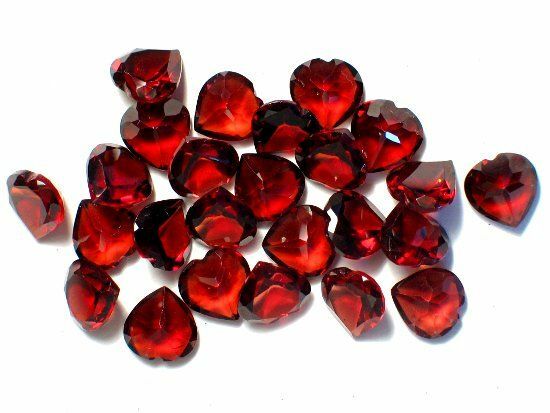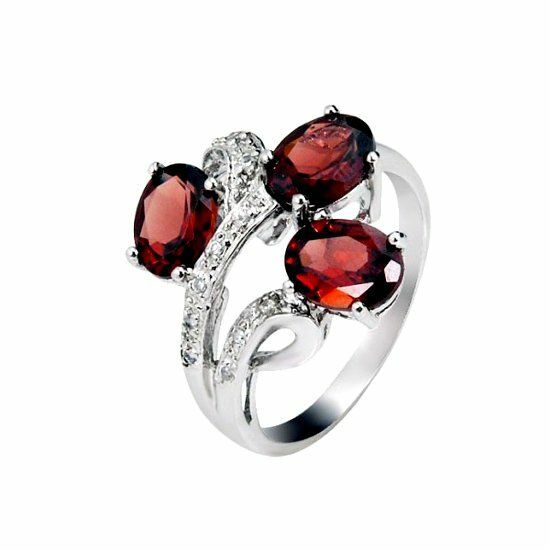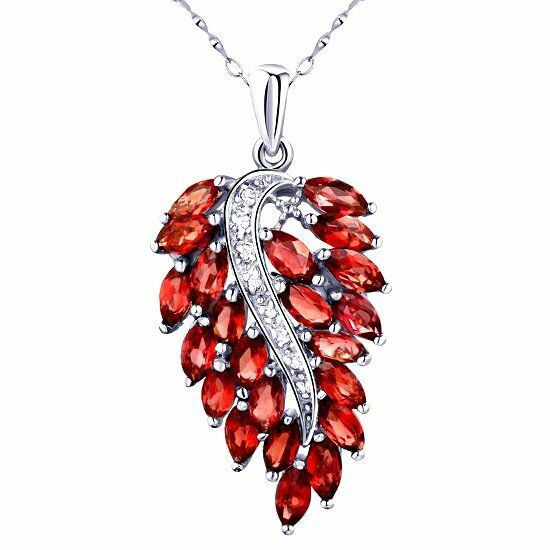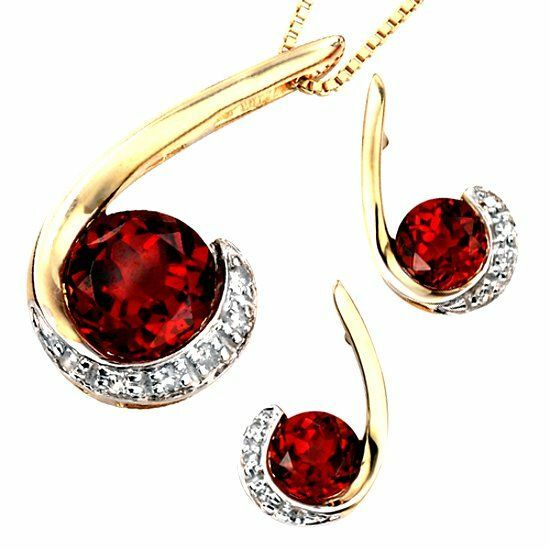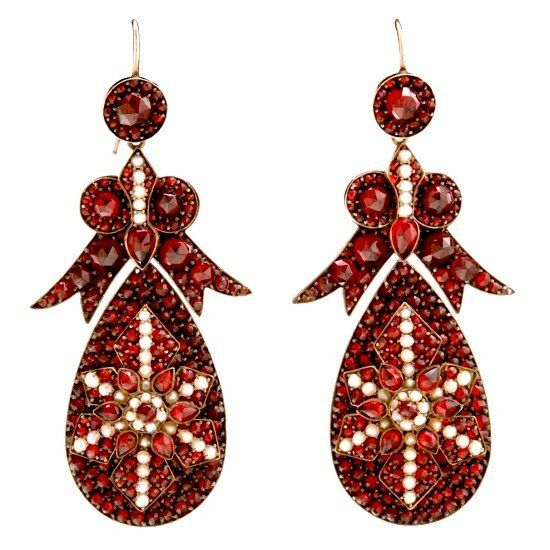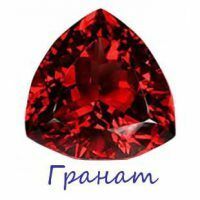
The pomegranate is one of the most beautiful and widespread stones loved by jewelers. However, often speaking of this gem, we represent only a stone of beautiful dark ruby color, while garnet has many varieties, and its color spectrum includes almost the entire color spectrum, except blue.
- Stone history
Description of the mineral- Garnet varieties
- Chemical composition and physical properties of the garnet
- Garnet deposits
- The healing properties of the garnet
- The magical properties of the mineral
- Garnet and zodiac signs
- Application of the gem
- Interesting facts about the stone
- How to distinguish natural garnet from forgery
- Photos of stone garnet and products from it
History of stone
Beautiful transparent stones of intense red color attracted people manymillennium. Jewelry, inlaid with grenades, were popular among Greeks, Scythians, Persians, and Romans.
In Ancient Greece, these stones were called "anthrax", which means "coal", in ancient Rome - "carbuncle", in Russia - "venisa", "chervets" or "beats".The last of the listed ancient Russian names of pomegranate corresponds to the Arabic name "bijazi".
These gems were carried with them as a talisman and a symbol of love, they encrusted rings and earrings, hats, military armor and court clothes. They admired and dedicated literary works.
Only in 1270 thanks to the medieval alchemist Albert Magnus, the general name of this beautiful gem - "garnet" has appeared. It came from the word "granatus"( lat.), Which in translation means "like the grains".Indeed, in its form this mineral resembles the grain of a real garnet.
Since 1803, this name has been applied not to one, but to a whole group of minerals that have similar properties and composition.
In the 17th and 19th centuries, garnet jewelry became extremely popular in Europe.
to contents ^Description of mineral
So, grenades are a group of minerals of silicate class, united by a common type of their crystal structure with isolated tetrahedrons( faces of square shape).
All of them have valuable physical properties - high mechanical strength, thermal and chemical resistance, the ability to reduce the speed of sound at the time when a sound wave passes through them. However, despite the identity of physical and chemical properties, the color scale of these precious stones is different - red, black, yellow and even green. It is determined by the chemical composition of the crystal.
It should be noted that only some varieties of garnets are precious stones, while others are not at all suitable for jewelry business. Initially, for jewelry used only "pyrope" - stones of a noble dark red color.
to the table of contents ^Garnet varieties
To date, there are 14 different types of garnets.
The most famous of them:
- Pyrope is a garnet of classic dark red color. Its name translates as "like fire."
- Almandin - the most common stone from the group of pomegranates. There is a red, brown and purple color. The name of this stone is derived from the name of the area where Alamanda is mined.
- Spessartin - garnet of pink, red and yellowish-brown color, received its name from the name of the area in Germany( Spessart).
- Andradite is a garnet of brown, red, greenish-brown and yellow hues, named in honor of the mineralogist from Brazil, Jose Bonifacio de Andrada e Silva, who opened it. Andradite has several subspecies:
- demantoid - a precious transparent stone of green color;
- melanite is a precious stone of black color.
- Grossular - garnet of unusual light green and greenish-brown hue. Its name is due to its similarity to the fruits of gooseberry( "grossularia").
- Uvarovit is a rare emerald-green garnet, named in honor of the President of the Russian Imperial Academy of Sciences, Count SS.Uvarov.
- Hessonite is a pomegranate honey-yellow or orange hue.
Chemical composition and physical properties of garnet
A group of minerals called garnets are divided into two separate subgroups:
- Iron-magnesian-manganese piralspit( these include almandine, pyrope, spessartine).
- Calcium urandites( these include grossular, uvarovite, andradite).
loading. ..
Each of these types of garnets has certain physical properties and chemical composition, but they are united by the general formula: R2 + 3 R3 + 2 [SiO4] 3, where R2 + is magnesium( Mg), iron( Fe), manganeseMn), calcium( Ca);R3 + - aluminum( Al), iron( Fe), chromium( Cr).
Elementary cells of garnet crystals have a cubic structure. Connecting, they form closed twenty-four-sided( tetra-giothreectahedra) and rhombododecahedrons - crystals consisting of 12 rhombuses.
The hardness of this group of minerals ranges from 6.5 to 7.5 on the Mohs scale, and the density is from 3830 to 3930 kg / m3.
to contents ^Pomegranate deposits
The world's most famous garnet deposits are in Australia, India, Argentina, Zambia, Austria, Brazil, Madagascar and Sri Lanka, Mexico, the USA, Norway, South Africa, as well as in Russia( in Chukotkaand in Yakutia).
Unusual green grenades are mined in the Urals and called "Ural".
to the table of contents ^The healing properties of the pomegranate
Many people from ancient times believed that pomegranate has outstanding healing properties. Thus, in the Middle Ages, in order to protect themselves from injuries and illnesses, the crusaders put on rings encrusted with grenades before the campaigns.
In Russia, folk healers believed that grenades can help pregnant women during childbirth.
In India, it is believed that the energy of the grenade is supported by immunity, the work of the heart and lungs.
And today, lithotherapists recommend wearing garnet with:
- high temperature;
- inflammatory processes;
- throat diseases;
- diseases of the pulmonary system( it is recommended to wear products made of stone on the neck);
- failure of the endocrine system;
- metabolic disorders;
- digestion disorders;
- allergies;
- skin diseases;
- systematic headaches( it is recommended to wear a stone trimmed in gold, and best of all on the middle finger of the right hand).
loading. ..
It is believed that garnet can have a beneficial effect on:
- emotional state;
- cardiac activity;
- wound healing;
- regeneration of organs and tissues;
- activity of the pituitary gland.
The magical properties of the mineral
Magic properties of pomegranate are covered with legends. First of all, this precious dark red stone was attributed to the ability to give power over people. That is why garnet was a talisman of reformers and converters, spiritually aspiring people.
Since ancient times, pomegranate is a talisman and all lovers. It is considered a symbol of loyalty, loyalty, permanence and strength. In the Middle Ages, lovers exchanged products encrusted with grenades.
Also garnet as a talisman is worn by sculptors, artists, poets, musicians, fashion designers, directors and actors - people of those professions whose success depends on their full return, emotionality and passion.
It is believed that the pomegranate is able to give its owner a good mood and drive away sadness, amuse the soul and bring joy, save from the leakage of energy and awaken passion.
to the table of contents ^Pomegranate and zodiac signs
Most of all garnets are like the zodiac signs, like:
- Lion;
- Sagittarius;
- Capricorn;
- Scorpio;
- Taurus.
These astrological signs are recommended for wearing red garnets, Libra and Aquarius are green. But the Cancer and Pisces grenades are not recommended to wear at all.
to table of contents ^Application of gem
Different types of pomegranates use:
- in jewelry( as a jeweler-ornamental stone);
- in the abrasive industry( for the production of pomegranate pelts, powders and grinding wheels);
- in the construction industry( as an additive to ceramic masses and cement);
- in electronics( as a ferromagnet);
- in instrument engineering( for the creation of lasers, optical systems).
Interesting facts about the stone
There are many different legends and beliefs related to pomegranate in different countries.
For example, it is believed that stealing this precious stone is dangerous, because a stolen grenade will sooner or later destroy a thief. But bought, donated or inherited stone will certainly bring good luck.
According to legend, it was the bright red garnet that illuminated the path to Noah and all the rescued on his ark.
In Persia, pomegranate was called only as a royal stone, because on its large stones it was decided to cut out a portrait of the ruler of the country.
In feudal Europe, stone was called the frozen flame of the human heart and was often given as a sign of love and devotion.
Very fond of grenades in the Czech Republic. Thus, the famous Czech composer and conductor Bedřich Smetana donated a necklace from large select dark red pomegranates to his wife as a sign of love after long happy years of life together.
Gave a set of garnets from his beloved and the famous German poet and statesman Johann Goethe.
Jewelry of pomegranate used to decorate herself Catherine II.Do not lag behind it and the modern crowned people of England and Belgium.
A special celebrity for the stone was the lyrical work of Alexander Kuprin "Pomegranate Bracelet".True, inspired the author to write this romantic story bracelet, inlaid not with red, but with an unusual green garnet.
to contents ^How to distinguish natural garnet from forgery
Granate is forged very rarely, because at its cost synthetically grown garnet is more expensive than natural stone.
However, if you doubt the authenticity of the garnet product, you can conduct a small experiment based on a mineral property such as light magnetism.
For him you will need:
- accurate scales,
- magnet;
- cork.
Stages of the experiment:
- Put pomegranate on the scales on the plug( to exclude the contact of the mineral with the metal).
- We remember the exact weight of the stone.
- Place a magnet close to the stone( at least 1 cm apart).
- Observe the balance arrow: under the influence of mineral magnetism, the pointer of the balance should begin to oscillate.
This is a fairly reliable way to make sure that the garnet is real. But the most accurate definition of a forgery is possible only with the help of a special device - binolupy.
to table of contents ^Pictures of garnet stone and its products
